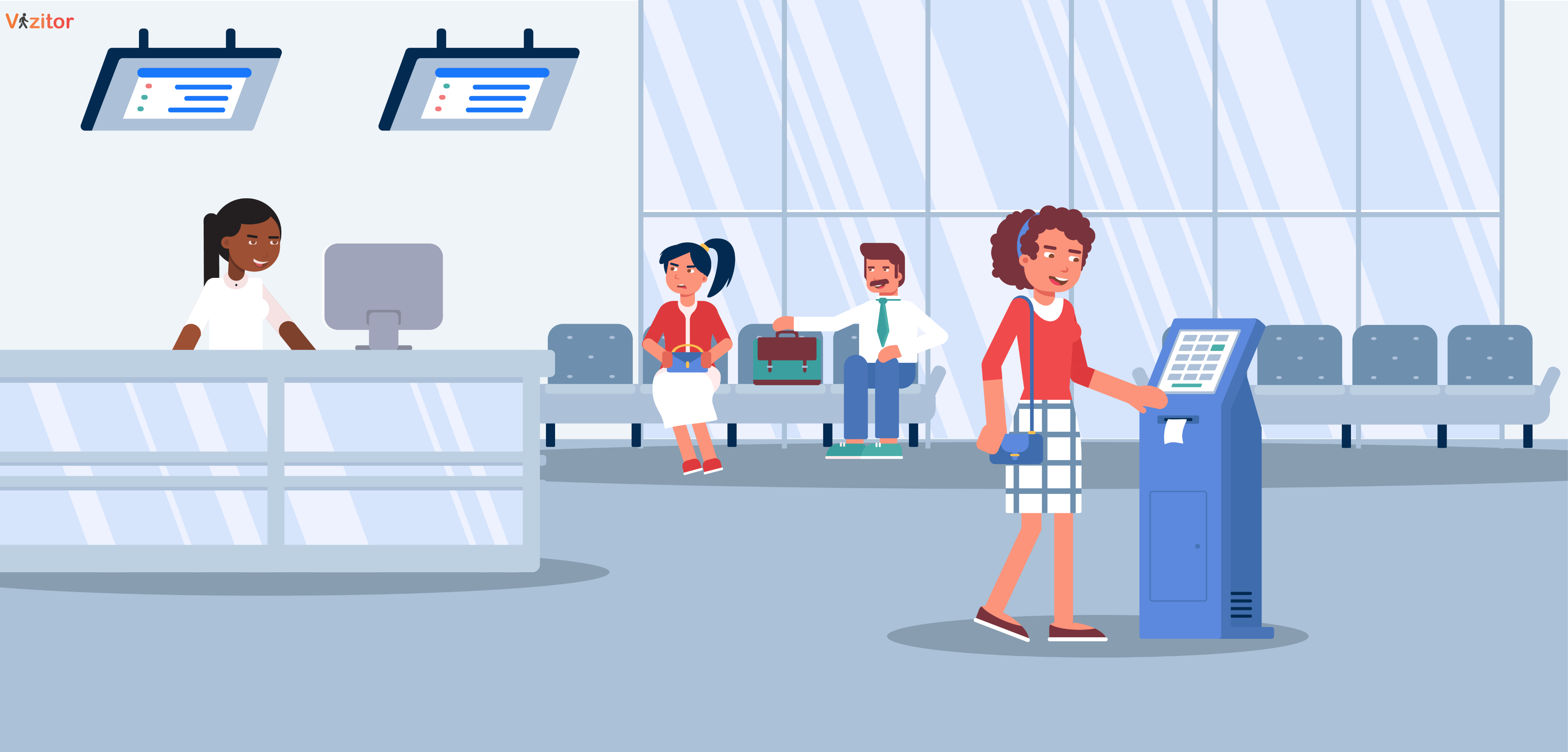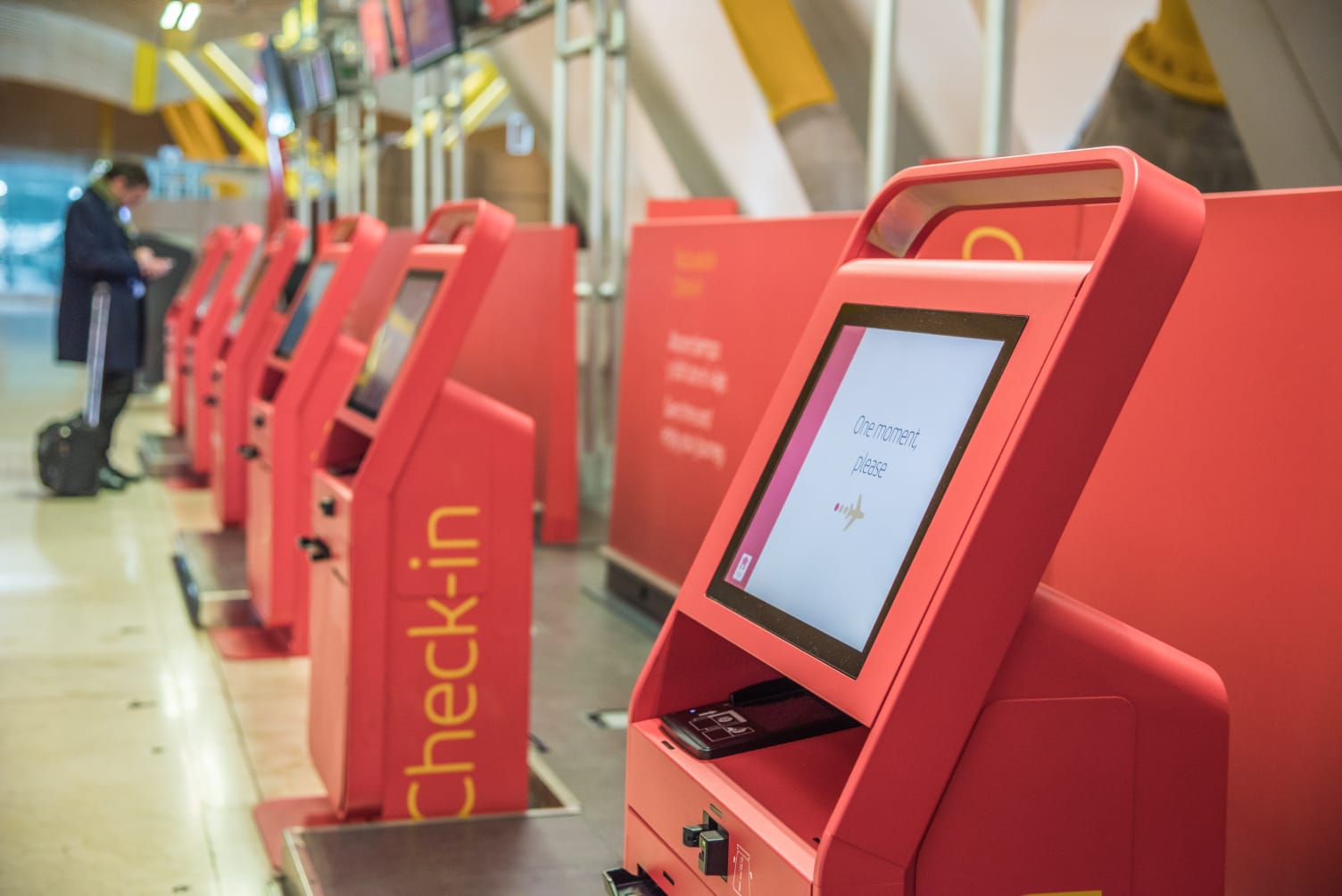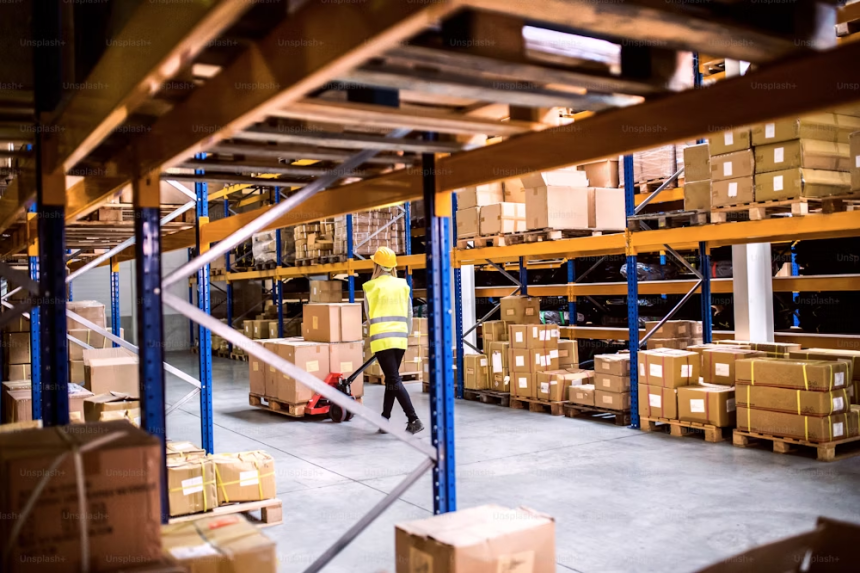Table of Content
Try Vizitor for Free!

Mon, Dec 30, 2024
Read in 11 minutes
Traveling is an exciting adventure, but long queues and overcrowded check-in counters can take away the joy.
Suppose you arrive at a busy airport with limited time to spare before your flight. The long lines at check-in counters feel daunting, and anxiety kicks in.
Traveling through airports can often be a chaotic experience, especially during peak seasons when long queues and crowded counters add to the stress.
However, self-service airport kiosks are here to change the game.
These sleek, tech-enabled systems have transformed how passengers navigate airports, offering faster check-ins, reduced wait times, and an overall seamless travel experience.
According to SITA’s 2023 Air Transport IT Insights, 83% of passengers prefer self-service kiosks over traditional counters due to their speed and convenience.
Let’s explore the world of self-service kiosks and see how they simplify traveling, improve queue management, and offer features that make airports more efficient.
What Are Self-Service Airport Kiosks?
Self-service airport kiosks are automated machines that allow passengers to manage their check-ins without requiring assistance from airline staff. They’re designed for speed, simplicity, and convenience, and they can handle tasks like:
- Checking in for flights
- Printing boarding passes
- Generating luggage tags
Sarah, a frequent business traveler, often arrives at the airport stressed about time. By using a self-service kiosk, she can quickly check in, print her boarding pass, and proceed directly to security, saving her valuable minutes.
The Role of Self-Service Check-In Kiosks at Modern Airports
Self-service check-in kiosks are strategically placed near airline ticketing areas, often close to baggage drop-off counters, ensuring passengers can conveniently access them.
They are often designed for front -line employees to streamline operational tasks.
Meeting Airport Goals
Airports and airlines aim to handle increasing passenger volumes while minimizing operational costs. Self-service kiosks have become central to achieving these objectives by:
- Reducing Manual Intervention: Enabling passengers to handle check-ins independently
- Decreasing Queue Times: Diverting traffic away from traditional counters
- Optimizing Resources: Allowing airport staff to focus on other critical tasks
A study at Los Angeles International Airport revealed that self-service kiosks reduced check-in times by 25%, enabling the airport to manage higher passenger volumes without adding extra staff.
Traditional Systems vs. Self-Service Airport Kiosks
Airports are hubs of activity where efficiency and convenience are paramount. With advancements in technology, self-service check-in kiosks have emerged as a modern alternative to traditional check-in systems.
Here’s a detailed comparison of the two:
1. Efficiency and Speed
Traditional Systems:
- Relies on human interaction at counters.
- Passengers wait in long queues during peak hours.
- Check-in time ranges from 5 to 20 minutes per passenger.
Self-Service Kiosks:
- Eliminates the need for manual assistance.
- Processes check-ins in under 3 minutes.
- Reduces congestion by handling multiple passengers simultaneously.
2. Accessibility and Convenience
Traditional Systems:
- Requires assistance from airline staff.
- Limited availability, especially during off-hours.
- May involve language barriers for international travelers.
Self-Service Kiosks:
- Accessible 24/7 in multiple languages.
- User-friendly interface with step-by-step instructions.
- Travelers can update information, select seats, and print boarding passes independently.
- Touchless Check-ins
Case Study:
During peak holiday travel, London Heathrow reported wait times exceeding 20 minutes at traditional counters.
After introducing kiosks, the average wait time dropped to 8 minutes.
3. Cost and Resource Allocation
Traditional Systems:
- Requires a large team of staff, increasing operational costs for airlines and airports.
- Staff must be trained for check-in, ID verification, and customer service.
Self-Service Kiosks:
- Reduces staffing needs, saving airlines up to 15% on operational costs.
- Minimal supervision required; kiosks handle routine tasks automatically.
4. Technology
- Limited use of technology; processes are heavily manual.
- Staff handles security checks manually.
Self-Service Airport Kiosks:
- Utilizes advanced technologies like facial recognition, QR codes, and biometric scanning.
- No physical interaction needed
While traditional systems remain essential for personalized assistance,modern airports worldwide are increasingly adopting kiosks to manage passenger flow and reduce overheads, striking a balance between human interaction and automation.
Studies shown that:
At Changi Airport in Singapore, self-service kiosks equipped with facial recognition technology allow travelers to check in, clear immigration, and board flights—all without interacting with airport staff. This has reduced check-in time by 40%, enhancing passenger satisfaction.

Top Self-Service Check-In Kiosk Providers Used in Airports
Airports worldwide rely on leading check-in kiosk providers to deliver fast and secure self-service experiences. Here are some of the top airport kiosk system providers transforming check-in processes globally:
| Brand / Provider | Used By | Key Feature |
|---|---|---|
| SITA | Major Global Airports | Contactless Check-in, Biometric Scanning |
| IER | European & North American Airports | Self Bag Drop, Multi-Airline Integration |
| Materna IPS | Lufthansa, Qatar Airways | Kiosks + Mobile Check-In, Bag Drop Solutions |
| Kaba Gallenschütz | Asia-Pacific Airports | Self-boarding Gates, Fast Track Check-ins |
These check-in kiosk systems help airports reduce queues and enhance passenger convenience. Understanding these systems can help you better navigate your next airport visit!
How To Use Self- service Kiosks at Airport
No body likes to stand for long in congested waiting lines and spend their valuable time in waiting rooms.
Self-service kiosks have revolutionized the airport experience by providing an efficient, quick, and personalized service to passengers.
These kiosks not only save time but also streamline the entire check-in and boarding process.
Self- service airport kiosks have streamlined the entire Queue Management process at airports.
Modern Queue Management Solutions like Vizitor offer various robust digital features such as self- service Kiosks, digital signage, real- time tracking etc. for optimizing the entire airport Queueing organisation.
Here’s how the self check-in airport kiosks work:
1. Simple and Efficient Check-In Process
The self-service kiosk allows passengers to check in for their flights independently, without needing to wait in long lines at the airline counter.
All you need to do is approach the kiosk, scan your ticket or enter your booking details, and the system will guide you through the process.
- Quick Seat Selection: You can select your preferred seat from available options displayed on the screen, giving you more control over your journey.
- Instant Boarding Passes: Once the check-in process is complete, the kiosk prints your boarding pass, saving you the hassle of waiting for a staff member.
How Vizitor’s Queue Management System Helps?
Airport terminals can get crowded, especially during peak travel times.
Vizitor ensures that passengers are directed to the right self-service kiosks based on real-time traffic flow.
This reduces congestion at check-in counters and ensures that passengers don’t waste time looking for available kiosks. With an organized flow of passengers, check-ins become faster, making the airport experience much smoother.
2. Quick and Hassle-Free Baggage Drop
Once you’ve checked in, self-service kiosks allow you to quickly proceed to baggage drop-off areas. After checking in at the kiosk, passengers can tag their own luggage, making the process much faster and more efficient.
- Luggage Tagging: You can print your luggage tag directly from the kiosk and attach it to your bag before heading to the baggage drop-off point.
- No Long Lines: With the self-service kiosk in place, passengers can bypass traditional counters and drop their baggage in a dedicated area, reducing wait times and streamlining the overall process.
How Vizitor Helps?
After checking in, you might need to proceed to a baggage drop-off point. Vizitor helps ensure that passengers are guided to the nearest available baggage drop area, improving the flow and ensuring minimal wait times.
By managing queues effectively, Vizitor also minimizes crowding at baggage drop stations, which in turn reduces overall airport congestion.
3. Convenient Boarding Pass and Seat Selection
Self-service kiosks at airports also offer passengers the ability to select their seats and print their boarding passes at the same time. This gives travelers more autonomy and flexibility.
- Easy Boarding Pass Printing: After completing the check-in process, the kiosk generates a boarding pass for you to print and take to your gate.
- Seat Preferences: You can choose seats according to your preference, whether it’s near the window, aisle, or extra legroom.
How Vizitor’s Queue Management System Helps?
Vizitor’s queue management system helps direct travelers to kiosks that are less crowded, ensuring that the process remains smooth.
Whether you’re in a rush or just prefer a quieter space, Vizitor ensures that you are guided to an available kiosk for printing your boarding pass and selecting seats, further reducing the wait time.
4. Stress-Free Experience
Beyond the basics of check-in and baggage drop, self-service kiosks offer a range of additional services that make your travel experience even more convenient.
- Flight Changes: If your plans change, you can use the kiosk to rebook or modify your flight without needing to interact with an airline representative.
- Seat Upgrades: Many kiosks also allow passengers to upgrade their seats directly through the kiosk interface, providing a seamless way to improve your travel comfort.
How Vizitor Helps?
At busy times, travelers often look for the best kiosk that offers their required services.
Vizitor’s queue management system ensures that passengers are efficiently guided to kiosks that can handle their specific requests—whether it’s checking in, upgrading seats, or modifying a booking.
This system prevents overcrowding and long lines at service points, keeping the airport experience efficient and organized.
5. Real-Time Notifications
Self-service kiosks don’t just focus on the check-in process. Many kiosks also display real-time updates about flight departures, arrivals, delays, and gate numbers.
- Instant Updates: These updates help passengers stay informed about any changes to their flight or gate, ensuring that they don’t miss any important information.
- Avoid Confusion: With everything displayed on the kiosk screen, you can easily stay up to date without searching through multiple sources.
How Vizitor Helps?
Vizitor plays a key role in ensuring that passengers don’t miss out on real-time information.
By managing queues and guiding passengers to appropriate kiosks, Vizitor ensures that everyone has access to the latest updates without wasting time.
Whether it’s a flight delay or a gate change, Vizitor keeps passengers informed and ensures they can act swiftly without waiting in line.
6. Multilingual Interface
One of the most important features of self-service kiosks is their ability to provide multiple language options.You can select the language you are comfortable in.
This is especially beneficial for international travelers who may not be fluent in the local language.
- Language Selection: Passengers can choose from a wide range of languages, making it easier for them to navigate the check-in process and other services.
- Ease of Use: This makes the airport experience smoother for everyone, regardless of where they come from.
Vizitor’s real-time interactive dashboard ensures that international travelers are guided to the kiosks that provide their preferred language.
7. What If Something Goes Wrong at the Airport Kiosk?
- Printer Error: Ask a nearby agent or proceed to a service counter.
- Booking Not Found: Double-check your booking reference and spelling; ask airline staff if needed.
- Boarding Pass Didn’t Print: Revisit the kiosk and select “Reprint Boarding Pass.”
- Luggage Tag Issue: Staff is always available near bag drop areas for help.
This improves the efficiency of the check-in process and ensures that passengers can easily understand all the steps involved in their travel.
Tips for Using Self-Service Airport Kiosks
- Have Your Documents Ready: Keep your booking reference or passport handy for quick check-in.
- Follow On-Screen Instructions: The kiosk will guide you step-by-step—just follow the prompts.
- Check Your Seat Selection: Make sure you choose your preferred seat before confirming.
- Print Your Boarding Pass: After check-in, don’t forget to print your boarding pass.
- Drop Your Bag Quickly: Use the self-service baggage drop to avoid waiting in long lines.
- Stay Updated: Look out for real-time flight updates on the kiosk screen.
- Use Accessible Features: Choose language and accessibility options for ease.
Real- World Case Studies
1. Hartsfield-Jackson Atlanta Airport (USA)
The introduction of kiosks helped reduce check-in wait times by 20%. Around 70% of passengers use kiosks for quicker service.
2. Los Angeles International Airport (USA)
LAX installed kiosks for check-ins and boarding passes, cutting down queues. 80% of passengers use them for faster service.
3. Dubai International Airport (UAE)
With 150+ kiosks for check-ins and baggage tagging, Dubai airport decreased wait times by 50%. Over 80% of travelers prefer using kiosks.
Future of Self check-in Airport Kiosks
Self-service kiosks at airports are just the beginning of a larger shift towards seamless, efficient, and stress-free travel experiences.
As technology advances, we can expect even smarter kiosks with biometric scans and real-time updates. This will not only enhance passenger convenience but also help airports manage traffic more efficiently.
Airports are increasingly looking to integrate self-service kiosks with other innovations like automated baggage handling systems, smart queue management solutions like Vizitor, and enhanced digital touchpoints to provide a holistic solution for travelers.
Vizitor’s queue management system, for example, helps streamline the flow of passengers, reducing wait times and improving overall satisfaction.
FAQs
What are self-service check-in kiosks at airports?
A self-service check-in kiosk is a digital machine that allows passengers to check in, select seats, print boarding passes, and even tag their luggage—without staff assistance.
Which airlines use self-service kiosks?
Most major airlines like Emirates, Delta, British Airways, Lufthansa, and Singapore Airlines use self-service kiosks globally.
Is kiosk check-in faster than counter check-in?
Yes. Kiosk check-in takes 3-5 minutes, while manual check-in can take 15-30 minutes during peak hours.
What if I can’t check in at an airport kiosk?
Simply ask a staff member nearby or visit the manual check-in counter for help.
Get Ready to Experience Hassle-Free Travel!
As airports continue to innovate, it’s clear that kiosks are here to stay. If you want to make your next trip smoother and faster, make sure to take advantage of these self-service kiosks.
Ready for faster check-ins?
Say goodbye to long lines and welcome a more efficient airport experience today, powered by smart technologies like Vizitor for seamless queue management!









